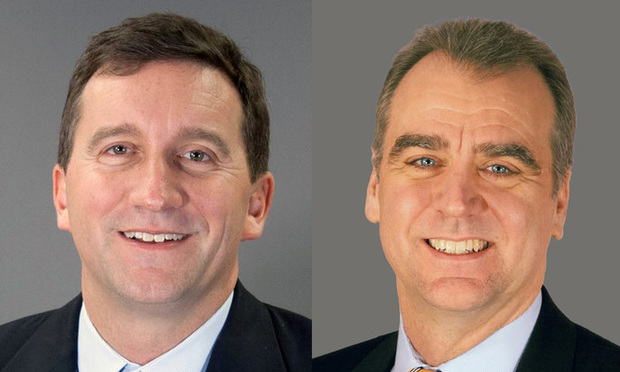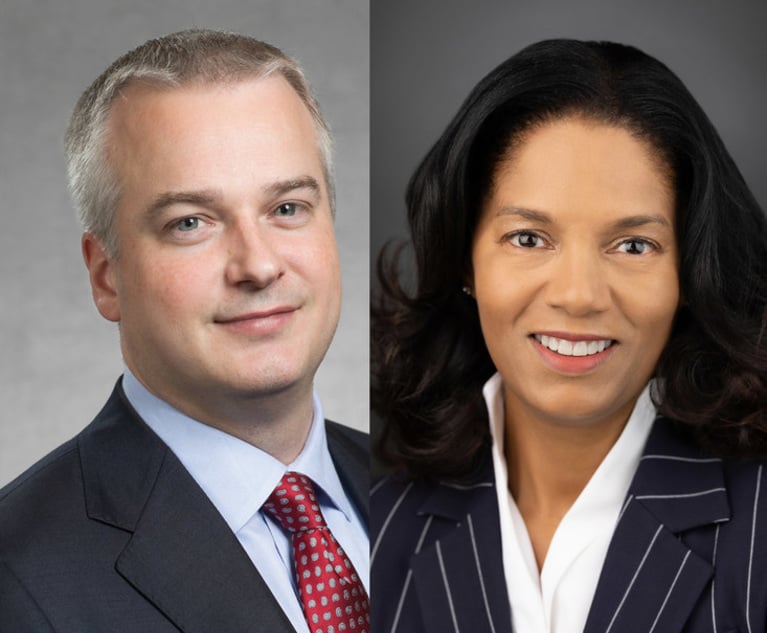Litigators of the Week: Latham's Lethal IP Litigators Kill Patent Challenge to $2B-a-Year Drug
Latham & Watkins global IP co-chair Michael Morin and partner David Frazier delivered a save worth billions to clients Janssen Biotech Inc. and Genmab A/S.
February 08, 2019 at 12:09 PM
11 minute read
 Michael Morin, left, and David Frazier, right, of Latham & Watkins.
Michael Morin, left, and David Frazier, right, of Latham & Watkins.
The Litigator of the Week crown goes to a Latham & Watkins global IP co-chair Michael Morin and partner David Frazier, who delivered a save worth billions to clients Janssen Biotech Inc. and Genmab A/S.
Janssen (which is part of Johnson & Johnson) and Genmab were sued for patent infringement by competitor MorphoSys AG, represented by Kirkland & Ellis. At issue: IP rights to blood cancer drug Darzalex, which Genmab invented and Janssen licensed and markets.
The stakes were huge—Darzalex had sales of more than $2 billion last year, and Fierce Pharma projects that number will hit $5 billion by 2022.
On Jan. 25, Chief U.S. District Judge Leonard Stark in Delaware ruled that the MorphoSys patents were invalid. But the case wasn't quite over. MorphoSys could (of course) appeal Stark's decision, and Janssen still had a counter-claim against MorphoSys. Instead, the two sides struck a deal on Jan. 31 to dismiss everything—no appeal, no counter-claim—leaving Janssen and Genmab secure in their rights to Darzalex.
Morin and Frazier discussed the case with Lit Daily.
Who is your client and what was at stake?
Mike Morin: Our clients are Janssen Biotech Inc., which is part of Johnson & Johnson, and Genmab A/S, which is a European biotechnology company. Janssen sells Darzalex, a blockbuster cancer drug that has been used more than 70,000 patients since its approval in 2015. Genmab invented Darzalex in the early 2000's, and partnered with Janssen in 2012 to help bring it to market.
David Frazier: This was a case between competitors. The plaintiff, MorphoSys AG, is another European biotech company that sued Janssen and Genmab for patent infringement. MorphoSys sought a significant royalty on sales of Darzalex.
Darzalex sales were over $2 billion dollars last year, and MorphoSys was seeking a continuing royalty for the life of their patents, thru 2028. The stakes were very high.
Without getting too technical, tell us a little more about multiple myeloma and how your client developed Darzalex as a treatment.
Morin: Multiple myeloma is a devastating blood cancer that affects hundreds of thousands of people around the world. Even patients who initially responded to traditional drug treatment typically relapsed, after which time their life expectancies were measured in months, not years.
Darzalex transformed multiple myeloma treatment, dramatically increasing the numbers of patients responding to treatment, lengthening their lives, and in some cases leaving them free of detectable cancer. It has been a miracle drug for many people, giving them hope when they were otherwise out of time and out of options.
Frazier: Darzalex is different from traditional cancer chemotherapeutic drugs because it is an antibody—similar to the antibodies your body makes to help you get well when you have a cold or the flu—but Darzalex targets cancer cells rather than germs.
Our client Genmab faced long odds when it began work on Darzalex in the early 2000s. It used an amazing technology involving genetically modified “transgenic” mice that make antibodies our immune system could never make. Against those odds, and at great risk, expense, and investment, Genmab spent 10 years developing Darzalex in the lab and in early clinical trials and then licensed it to Janssen to finish clinical trials and get it to market. Janssen has performed dozens of clinical trials with Darzalex, and continues to invest in new ways to use it.
How did you get involved in the case?
Morin: The clients brought us on board in middle of the case. We are very familiar with the issues in antibody patent cases. Over the last ten years, we have been fortunate to work with other sophisticated pharma clients that develop antibody drugs.
David has a Ph.D. in molecular biology, and I'm more of a traditional trial lawyer. Together, we put together arguments grounded in the details of the science—which is David's specialty, but that still speak to judges and juries, which is where I come in.
Frazier: This is one of the major challenges of this type of case. Details of antibody engineering are even less familiar to most people than technologies in cell phones and computer networks. For our arguments to be persuasive, we need to present facts in a way that is scientifically robust and accurate but understandable and convincing to non-scientific audiences.
Who was opposing counsel and how would you describe their approach to litigating the case?
Morin: The opposing firm was Kirkland & Ellis, a top tier firm. Jim Hurst and Pat Carson led the team. They are experienced pharma patent litigators, with excellent track records and reputations, so we knew nothing would come easy.
What were the over-arching themes of your defense?
Frazier: From the start, our theme was that MorphoSys was overreaching. It had patented too broadly by trying stretch its patent to cover Darzalex, something it didn't invent or teach in the patent.
The Darzalex story is a great one, independently invented and developed by Genmab and successfully brought to market by Janssen. Although MorphoSys' patent disclosed a small number of specific antibodies, they were very different from Darzalex and none of them ever made it to a clinical trial. That was something we thought would appeal to common sense.
How did you and your team work together in building your case?
Frazier: The Latham IP litigation model is to prepare for trial from day one, but we also want to set the case up for early exit. Avoiding trial through summary judgment is a huge plus for clients in terms of expense. Also, certain arguments may be better presented to the judge than the jury.
These cases operate on multiple levels: while the jury story is about common sense, you have to dive into the technical details with experts and check the boxes that the judge will look at to make sure the arguments are legally sound.
We assembled a team we knew could do all these things. Roger Chin, our other lead partner on the case, has an MD degree, and our two senior associates Brenda Danek and Michael Seringhaus both have science PhDs, but all three are very experienced at translating the science into legal arguments.
Morin: The in-house lawyers and scientists at both Janssen and Genmab were a critical part of the team as well. They were extremely invested in the case, and worked hand-in-hand with our Latham legal team to develop the evidence and arguments needed to win the case.
We recognize that in-house counsel are in the best position to know their client's business and strategic priorities. In this case, in-house counsel were very much part of the core litigation team, attending depositions and hearings and developing case strategy. We couldn't have succeeded without them. And from day 1, we worked hard to find experts who were at the top of their fields but who could also communicate clearly. We like teachers and always ask potential experts what courses they teach and how they convey complicated ideas.
My colleague Scott Graham wrote that you used a lot of MorphoSys AG's own expert testimony against them. How did you do that?
Frazier: The legal standard for summary judgment requires that there are no meaningful factual disputes between the parties, so the court can decide specific issues as a matter of law. The key to winning is to find areas where the experts agree rather than focusing only on the facts most helpful to your side of the case. We pursued this strategy both in working with our own experts and when deposing the other side's experts.
Morin: With all the technology and economic issues, there were 16 experts between the parties. The case could easily have turned into a classic “battle of experts,” but disputes among the experts would have to go to a jury.
We stayed focused while writing and arguing our summary judgment motions, carefully selecting our evidence and arguments that we knew the other side's experts had bought into during the depositions. It's not easy to leave behind a key piece of evidence, but putting everything you have into the summary judgment briefs creates factual disputes and is counterproductive.
A jury trial was set to begin February 11, 2019 in front of Chief Judge Stark in the District of Delaware. What happened instead?
Morin: We were preparing for the jury trial, but Chief Judge Stark had taken the briefing and heard oral arguments on summary judgment in late November of 2018. We knew he typically rules on summary judgment before the pretrial conference, and sure enough, he issued his ruling on January 25, about a week before the conference.
The key point in that ruling was that all of the asserted claims were invalid because they were too broad (lack of enablement). He also found a subset of the claims were not infringed because the patent had defined human antibodies in a way that excluded antibodies like Darzalex that had been made with transgenic mice. Even though these were summary judgment rulings and not jury verdicts, they still flowed from the case theme—overreaching in the patent—we had been developing for nearly two years.
What to you were some of the highlights of Judge Stark's decision? (And what was your reaction when it was issued?)
Frazier: The decision showed a remarkable level of thought and detail given that the court had less than two months, including the holidays, to get it completed. Anyone who wonders how hard district court judges work need only look at the mountain of briefing and the detailed analysis of the decision to know that it required a lot of time and diligence. We were obviously thrilled with the decision, and our clients were delighted.
Even after Judge Stark ruled that MorphoSys' three patents were invalid, the case wasn't entirely over—and indeed, it's possible might have dragged on for years on appeal. Tell us about the final resolution.
Morin: After the patents had been invalidated, we retained an inequitable conduct counterclaim that needed to be tried to the court.
Ultimately, though, the parties agreed that MorphoSys would dismiss its claims and forego appeal, and Janssen and Genmab would dismiss that counterclaim. The case was dismissed on January 31. With this lawsuit behind them, hopefully, all parties can get back to their core mission of developing new drugs to help patients.
What do you hope might be the legacy of this litigation?
Frazier: Summary judgment is unusual in patent cases, particularly on patent validity issues. Parties can become resigned to the idea that because the technology is complex and both sides will engage experts with opposing opinions, the cases are not amenable to summary judgment. This case shows that even large and complicated cases can be set up for summary judgment with the proper level of focus and discipline throughout the litigation.
Morin: I'd like to think this case shows the power of developing case themes early, pursuing them throughout discovery, and then presenting them to the court at the earliest opportunity to achieve the client's goals.
This content has been archived. It is available through our partners, LexisNexis® and Bloomberg Law.
To view this content, please continue to their sites.
Not a Lexis Subscriber?
Subscribe Now
Not a Bloomberg Law Subscriber?
Subscribe Now
NOT FOR REPRINT
© 2025 ALM Global, LLC, All Rights Reserved. Request academic re-use from www.copyright.com. All other uses, submit a request to [email protected]. For more information visit Asset & Logo Licensing.
You Might Like
View All
Litigators of the Week: A Trade Secret Win at the ITC for Viking Over Promising Potential Liver Drug

Litigation Leaders: Mark Jones of Nelson Mullins on Helping Clients Assemble ‘Dream Teams’

Litigators of the Week: Ingersoll Rand Enforces a Noncompete Against an Exec Who Jumped Ship to Verboten Competitor

Litigator of the Week: After Years Repping Prenatal Testing Client, First-Time First Chair Lands a $57M Patent Damages Verdict
Trending Stories
Who Got The Work
J. Brugh Lower of Gibbons has entered an appearance for industrial equipment supplier Devco Corporation in a pending trademark infringement lawsuit. The suit, accusing the defendant of selling knock-off Graco products, was filed Dec. 18 in New Jersey District Court by Rivkin Radler on behalf of Graco Inc. and Graco Minnesota. The case, assigned to U.S. District Judge Zahid N. Quraishi, is 3:24-cv-11294, Graco Inc. et al v. Devco Corporation.
Who Got The Work
Rebecca Maller-Stein and Kent A. Yalowitz of Arnold & Porter Kaye Scholer have entered their appearances for Hanaco Venture Capital and its executives, Lior Prosor and David Frankel, in a pending securities lawsuit. The action, filed on Dec. 24 in New York Southern District Court by Zell, Aron & Co. on behalf of Goldeneye Advisors, accuses the defendants of negligently and fraudulently managing the plaintiff's $1 million investment. The case, assigned to U.S. District Judge Vernon S. Broderick, is 1:24-cv-09918, Goldeneye Advisors, LLC v. Hanaco Venture Capital, Ltd. et al.
Who Got The Work
Attorneys from A&O Shearman has stepped in as defense counsel for Toronto-Dominion Bank and other defendants in a pending securities class action. The suit, filed Dec. 11 in New York Southern District Court by Bleichmar Fonti & Auld, accuses the defendants of concealing the bank's 'pervasive' deficiencies in regards to its compliance with the Bank Secrecy Act and the quality of its anti-money laundering controls. The case, assigned to U.S. District Judge Arun Subramanian, is 1:24-cv-09445, Gonzalez v. The Toronto-Dominion Bank et al.
Who Got The Work
Crown Castle International, a Pennsylvania company providing shared communications infrastructure, has turned to Luke D. Wolf of Gordon Rees Scully Mansukhani to fend off a pending breach-of-contract lawsuit. The court action, filed Nov. 25 in Michigan Eastern District Court by Hooper Hathaway PC on behalf of The Town Residences LLC, accuses Crown Castle of failing to transfer approximately $30,000 in utility payments from T-Mobile in breach of a roof-top lease and assignment agreement. The case, assigned to U.S. District Judge Susan K. Declercq, is 2:24-cv-13131, The Town Residences LLC v. T-Mobile US, Inc. et al.
Who Got The Work
Wilfred P. Coronato and Daniel M. Schwartz of McCarter & English have stepped in as defense counsel to Electrolux Home Products Inc. in a pending product liability lawsuit. The court action, filed Nov. 26 in New York Eastern District Court by Poulos Lopiccolo PC and Nagel Rice LLP on behalf of David Stern, alleges that the defendant's refrigerators’ drawers and shelving repeatedly break and fall apart within months after purchase. The case, assigned to U.S. District Judge Joan M. Azrack, is 2:24-cv-08204, Stern v. Electrolux Home Products, Inc.
Featured Firms
Law Offices of Gary Martin Hays & Associates, P.C.
(470) 294-1674
Law Offices of Mark E. Salomone
(857) 444-6468
Smith & Hassler
(713) 739-1250






